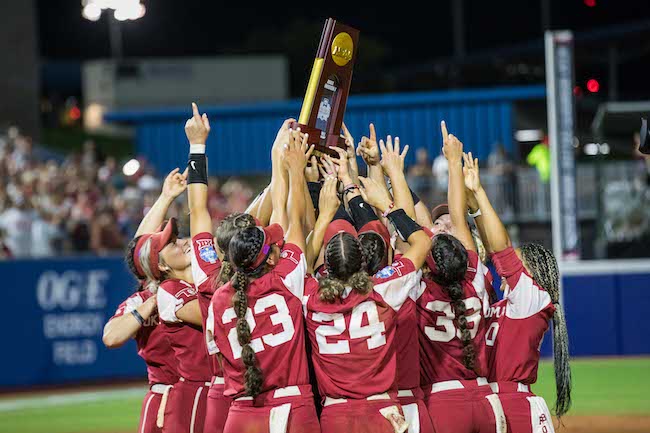In AEC, we’re always looking for a competitive advantage. In fact, I’m guessing over the course of your career, you’ve likely read a few books or attended some conferences and webinars with the goal of staying on top of the industry and advancing your business or career.
But did you know you can learn how to sharpen your AEC firm’s competitive edge by watching…fastpitch softball?
Hear me out.
Every June, I get sucked into the drama of the NCAA Women’s College World Series in Oklahoma City. It’s always an added bonus that there are consistently some hometown powerhouses in the mix (Boomer Sooner! Go Pokes!). And as I binged watched some exciting games this past weekend, I reflected on how underrated and unique the sport is.
Incidentally, I realized some of the features (dare I say improvements?...) that distinguish it from baseball not only make softball a more exciting sport to watch (an argument for another day), they create some interesting learning points. Career and business lessons that especially apply to the AEC industry.
Don’t believe me? Step up to the plate and see what AEC firms can learn by taking in a few games of fastpitch softball at the WCWS:
1. Are you prepared for more than just curveballs?
When a batter steps into the box, not only is she facing down 70 mph pitches from 43 ft away, she has to be prepared for movement – of every kind.
In softball, hitters rarely ever see a straight fastball, and yet “curveball” doesn’t even scratch the surface of what gets thrown their way. Every pitcher will have her specialties, but her arsenal will often encompass a variety of breaking balls that could include a curve (towards the pitcher’s glove side), screw (towards the pitcher’s throwing side), drop (down), rise (up), or even some combinations.
AEC professionals will tell you they're used to handling "curveballs," whether incorporating a last minute design change or handing an unforeseen condition on the job site. But what about a screwball? Or a drop? Or even a rise?
With constantly evolving technology and higher client expectations for fast and flashy deliverables, the AEC industry is a whirlwind of change. Simply adapting to curveballs isn’t enough anymore. You need to be able to evaluate and react at a moment’s notice to incoming pitches spinning every direction. Recognize what’s in your zone. Foul off what you need to hang on for a better opportunity. Make lightning-quick adjustments for solid contact.
Like softball players, AEC professionals don’t often deal with straight fastballs, but the industry is throwing much more than just curveballs. Are you ready?
2. How are you handling compressed timelines?
3.0 seconds.
In softball, that’s about how long an infielder has to field a ball and make a throw to first. With a fast lefty at the plate, that time can drop to 2.8 seconds or less.
In baseball? That number is closer to 4.2.
Of course, baselines are 60 ft in softball as opposed to 90 ft in baseball, and everything is just closer and more compact. But that also means everything unfolds faster. Infielders have less time to react. Less time to field it cleanly and fire to a base.
How do you consistently execute in such a short amount of time?
Fundamentals - Practice your technical skills until they are automatic. Confidence - Trust in your abilities and know your teammates will do their part. Planning - Know the situation and how you need to react depending on what unfolds.
Wait a minute, am I talking about softball or AEC??
As it turns out, the principles are pretty interchangeable.
In AEC, timelines and scheduling expectations are becoming tighter and tighter. And contractors and consultants who can meet the demand of crunched schedules are being rewarded. In order excel, you have to 1) execute the basics automatically and flawlessly, 2) know you can rely on you and your team's technical skills and services, and 3) understand your current workload and have your processes down to a science so you can seamlessly manage what comes in.
Fast turnarounds have never been so important. Knowing your services are built on solid fundamentals and being able to trust your team and processes will help you deliver quality work faster
3. Are you getting runners on base?
One of the more unique features of fastpitch is the lefty slapper. These speedy lefties essentially get a step or two headstart as the pitch comes in and then can drop a bunt in front of the plate, chop a high grounder between infielders, poke a looping fly ball in a hole, or punch a line drive through a gap.
Their goal is simple: put the ball in play to find a hole or beat out a throw.
While their tactics may not be glamorous, slappers can be hugely valuable to an offense. Why? Simply because they get on base. They give their team the opportunity to generate runs when big bats come to the plate.
In AEC, it’s easy to get caught up chasing the “home run” projects. But are you getting runners on? Are you willing to take on what might be considered unexciting or smaller jobs? Because those are your base runners. Those keep the inning going with certain clients and give you the opportunity to get to the heavy hitters. And when you capitalize, you capitalize big. All because you did the gritty work to get a runner on base.
So concentrate on getting runners on. Take the small jobs. Help your best clients out however you can. Because that’s what will bring about big opportunities.
Who knew softball had so much in common with AEC? Are you intrigued? Don’t worry, you still have time to catch some games – championship series starts tonight!
Come for the AEC learning points (obviously). Stay for the jaw-dropping talent and fast-paced entertainment…



There are no comments.